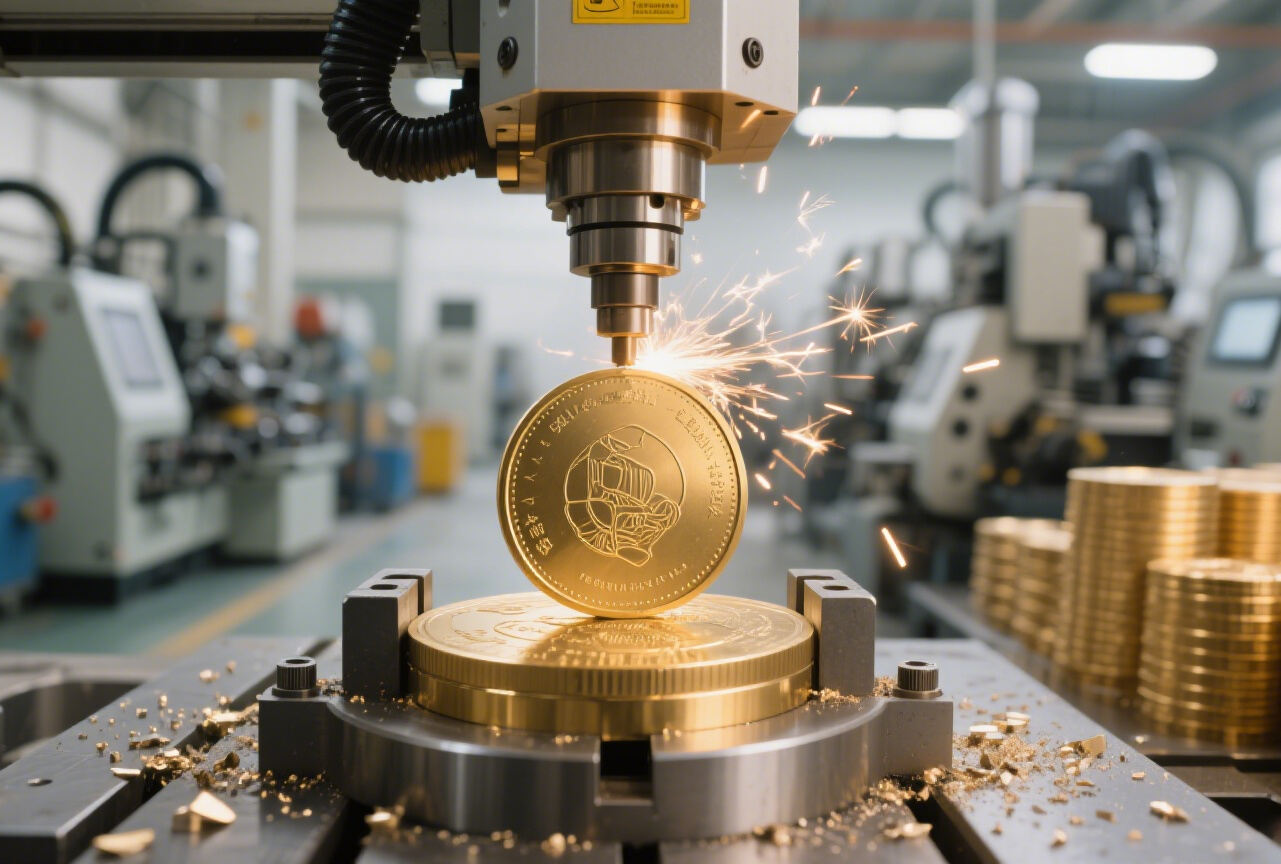
In the realm of brass coin production, laser engraving and traditional stamping serve distinct roles, each offering unique advantages. Laser engraving excels in precision, enabling the creation of intricate designs with unparalleled accuracy and detail, often surpassing the capabilities of traditional stamping methods. This technology allows for designs that are not achievable through stamping, including complex patterns and fine text. Statistics reveal that laser engraving significantly enhances speed and efficiency, reducing production time by up to 30% compared to conventional stamping methods. Nonetheless, traditional stamping remains preferred in specific scenarios, such as mass production runs where speed and cost-effectiveness are prioritized. The choice between these methods should be guided by production goals, whether it's achieving intricate detailing with laser engraving or capitalizing on the rapid, high-volume output offered by stamping.
Incorporating 3D sculpted details into brass coin production is increasingly crucial for enhancing aesthetic appeal. 3D sculpting involves using advanced technology and software to create depth and sophistication in coin designs, taking visual allure to another level. Popular software like ZBrush and Blender have revolutionized this aspect, ensuring coins possess lifelike textures and intricate dimensions that stand out. Famous coins, such as the commemorative American Eagle series, successfully utilize 3D sculpted details, notably increasing their demand and market value. Such enhancements not only elevate visual appeal but also attract collectors and investors, thus driving up intrinsic and perceived value.
Balancing aesthetics with functional design is vital in crafting brass coins that are both visually pleasing and practical. While aesthetics draw attention, the usability aspects of a coin profoundly affect its durability and handling. Functional design elements, including weight distribution and texture, ensure coins withstand regular use without losing their charm. Case studies, such as the specific design choices made in the production of currency coins in New Zealand, illustrate how a balanced approach leads to high marks in customer feedback. Experts consistently emphasize the importance of functionality, noting that while aesthetic beauty is impactful, the true value of a coin lies in its ability to resist wear and serve its intended purpose seamlessly. Achieving this balance ensures the coin remains a cherished artifact, admired for both its appearance and utility.
When considering coin production, brass presents a notable advantage due to its malleability and resistance to corrosion. These properties allow brass to be easily shaped and to endure over time, making it a preferred choice in crafting coins. In comparison, while stainless steel is also resistant to corrosion and provides strength, it lacks the same level of malleability as brass, often necessitating more complex processes for crafting detailed designs. Cost-wise, brass often proves to be more economical, especially in large-scale production, offering an optimal balance between quality and expense. Market trends indicate a steady preference for brass in the collectibles sector, with its warm hue adding an aesthetic appeal that influences consumer choice. Brass, with its rich color and pliant nature, tends to create coins with a luxurious look, whereas stainless steel delivers a more industrial or modern appearance.
Aluminum's lightweight nature sets it apart from both brass and stainless steel, making it particularly suitable for applications where weight is a critical factor. It is often chosen for promotional items or lighter designs due to its ease of handling and affordability. For instance, an aluminum coin would weigh significantly less than a brass counterpart, providing practicality in designs that need to be distributed in large volumes. Thus, aluminum is often preferred where cost and ease of delivery are priorities. However, its lesser resistance to wear compared to brass may limit its use in high-value or high-contact applications. The decision to employ aluminum over brass often hinges on the specific requirements of the design and its intended usage. These factors, including weight, cost, and expected longevity, all influence whether aluminum becomes the material of choice.
The mechanical properties of brass significantly contribute to the longevity of coins, offering durability and sufficient resistance to wear. Environmental factors, such as exposure to moisture and fluctuating temperatures, can also influence the choice of base material, with brass commonly chosen for its ability to withstand such conditions without degradation. Industry experts employ a suite of testing methods, including stress endurance and environmental resistance tests, to assess a material's durability. Understanding these factors can reveal common failures in coin production, such as warping or corrosion, often associated with improper material selection. Consequently, selecting the right base material by keeping durability in perspective ensures high-quality coin production and extends the lifespan of the coins significantly.
Die striking is a critical technique in coin production, enabling the creation of detailed and intricate designs. It involves using a hardened steel die to stamp the design onto metal blanks, providing remarkable precision. Recent advancements in die technology have revolutionized this process, significantly improving precision and reducing material waste. For instance, precision die striking has been shown to increase production speeds by approximately 25% due to minimized errors and rework. However, consistent quality in die striking requires regular maintenance and careful calibration of the dies, ensuring uniform output. This combination of advanced technology and maintenance is essential for achieving high-quality stamps in brass, stainless steel, and other materials.
Edging techniques play a vital role in enhancing the aesthetics and tactile experience of brass coins. Various options are available, including diamond cuts and reeded borders, each imparting distinct visual and physical attributes. Unique edging provides a tactile experience that can influence consumer perception and enhance brand identity. An example is evident in promotional coins where reeded edges add uniqueness and sophistication, strengthening brand recognition. Experts suggest selecting edging techniques based on the coin's intended use, ensuring the design complements its broader branding strategy.
The finishing process in coin production, particularly deburring and polishing, ensures that coins have high-quality surface finishes. Removing sharp edges and imperfections, deburring is integral to achieving a smooth finish. Polishing further enhances the coin's appearance, resulting in a lustrous surface. Best practices in this area include using high-quality tools and specific techniques tailored to each material, from stainless steel stamping to aluminum metal stamping. Comparisons of various methods reveal that vibratory finishing machines are effective in producing consistent results. Expert advice on troubleshooting common polishing issues, such as uneven surfaces or residues, often emphasizes the importance of correct machine settings and regular cleaning routines. By implementing these strategies, production achieves the desired surface quality, aligning with industry standards.
Electroplating is a crucial process in enhancing the aesthetic appeal and durability of coins. By applying a thin layer of metal onto the surface, electroplating provides both protection and visual appeal. Gold finishes are renowned for their brilliance and elegance, providing a luxurious allure, whereas antique finishes offer a timeless, weathered look that exudes history and tradition. Market trends indicate a strong consumer preference for gold due to its perceived value; however, antique finishes have carved their niche among those seeking a unique, classic appearance. The choice between the two often hinges on consumer preferences, which can significantly influence surface treatment decisions.
Epoxy color fill is an innovative technique used to add vibrant hues to brass coins. By filling recessed areas with epoxy resin, the colors achieve a robust shine and excellent longevity. Various techniques, such as soft and hard enamel fill, ensure the designs' endurance, protecting them against wear. Notable projects such as branded promotional coins have successfully utilized epoxy color fills to establish strong brand recognition. Experts often emphasize selecting the right epoxy based on the desired effect and the coin's use environment, ensuring optimal results in terms of durability and appearance.
Dual plating is a versatile technique that leverages the visual contrast between different metals on the same coin. This method involves applying two distinct metal layers, like gold and silver, to craft visually striking designs that catch the eye. Creative use of such combinations can vastly enhance a coin's appeal, as seen in various market stories where dual-plated coins became collectibles due to their standout appearance. For achieving the best results, experts suggest proper planning in the dual plating process to maintain the integrity and cohesiveness of the design elements. The outcome is a unique product that blends aesthetic diversity with lasting impact.
Tolerance checks are crucial in maintaining product quality during the stamping process of brass coins. These precision checks ensure that each coin meets strict dimensional criteria, preventing discrepancies that could affect the coin's functionality and aesthetic appeal. According to industry research, maintaining tight tolerances can significantly enhance consumer satisfaction rates, as consistency in product dimensions directly correlates with perceived quality. Various tools, such as calipers and micrometers, are employed in production to check tolerances accurately. For example, companies renowned for their excellence in maintaining tight tolerances often utilize automated optical inspection systems that minimize human error, ensuring every coin is produced to exacting standards.
Corrosion resistance testing is fundamental in prolonging the lifespan of brass coins. It involves subjecting coins to various environmental conditions to evaluate their durability over time, thereby ensuring they remain intact and visually appealing for years. Common methods include salt spray testing and humidity exposure, which simulate harsh environmental effects on the materials. Statistics reveal that a significant percentage of coins fail these tests when inadequately treated, highlighting the need for rigorous testing protocols. Recent innovations in testing methods, like electrochemical techniques, have improved the accuracy and precision of corrosion assessments, leading to better protective solutions being adopted in manufacturing processes.
Achieving ISO 9001 compliance is a significant milestone for brass coin manufacturers, as it signifies adherence to international quality management standards. This standardization ensures a systematic approach to managing processes and improving overall efficiency and effectiveness. ISO 9001 certification offers several benefits, including enhanced process efficiency and increased customer trust due to the guaranteed quality of products. There are numerous success stories within the industry where companies have significantly improved operations upon attaining ISO 9001 certification. Experts emphasize that standardized quality management systems are integral in fostering a culture of consistent quality improvement and customer satisfaction.


Copyright © 2024 by Xiamen Tongchengjianhui Industry & Trade Co., Ltd. - Privacy policy